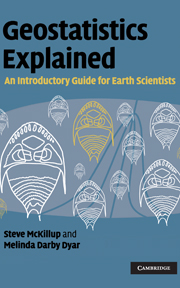Book contents
- Frontmatter
- Contents
- Preface
- 1 Introduction
- 2 “Doing science”: hypotheses, experiments and disproof
- 3 Collecting and displaying data
- 4 Introductory concepts of experimental design
- 5 Doing science responsibly and ethically
- 6 Probability helps you make a decision about your results
- 7 Working from samples: data, populations and statistics
- 8 Normal distributions: tests for comparing the means of one and two samples
- 9 Type 1 and Type 2 error, power and sample size
- 10 Single-factor analysis of variance
- 11 Multiple comparisons after ANOVA
- 12 Two-factor analysis of variance
- 13 Important assumptions of analysis of variance, transformations and a test for equality of variances
- 14 Two-factor analysis of variance without replication, and nested analysis of variance
- 15 Relationships between variables: linear correlation and linear regression
- 16 Linear regression
- 17 Non-parametric statistics
- 18 Non-parametric tests for nominal scale data
- 19 Non-parametric tests for ratio, interval or ordinal scale data
- 20 Introductory concepts of multivariate analysis
- 21 Introductory concepts of sequence analysis
- 22 Introductory concepts of spatial analysis
- 23 Choosing a test
- Appendices
- References
- Index
11 - Multiple comparisons after ANOVA
Published online by Cambridge University Press: 05 June 2012
- Frontmatter
- Contents
- Preface
- 1 Introduction
- 2 “Doing science”: hypotheses, experiments and disproof
- 3 Collecting and displaying data
- 4 Introductory concepts of experimental design
- 5 Doing science responsibly and ethically
- 6 Probability helps you make a decision about your results
- 7 Working from samples: data, populations and statistics
- 8 Normal distributions: tests for comparing the means of one and two samples
- 9 Type 1 and Type 2 error, power and sample size
- 10 Single-factor analysis of variance
- 11 Multiple comparisons after ANOVA
- 12 Two-factor analysis of variance
- 13 Important assumptions of analysis of variance, transformations and a test for equality of variances
- 14 Two-factor analysis of variance without replication, and nested analysis of variance
- 15 Relationships between variables: linear correlation and linear regression
- 16 Linear regression
- 17 Non-parametric statistics
- 18 Non-parametric tests for nominal scale data
- 19 Non-parametric tests for ratio, interval or ordinal scale data
- 20 Introductory concepts of multivariate analysis
- 21 Introductory concepts of sequence analysis
- 22 Introductory concepts of spatial analysis
- 23 Choosing a test
- Appendices
- References
- Index
Summary
Introduction
When you use a single-factor ANOVA to examine the results of a mensurative or manipulative experiment with three or more samples or treatments, a significant result only indicates that one or more appear to come from populations with different means. It does not identify which particular treatment means appear to be from the same or different populations.
A significant difference among the means of the three treatments A, B and C can occur in several ways. Mean A may be greater (or less) than B and C; mean B may be greater (or less) than A and C; mean C may be greater (or less) than A and B, and finally means A, B and C may all be different to each other. For example, in Chapter 10 we discussed data for the δ18O of pegmatites from three locations in Maine. A single-factor ANOVA will only tell you whether (or not) there is a significant difference in δ18O among these three locations.
If the treatments have been chosen as random representatives of all the possible treatments available (i.e. the factor is random so you have done a Model II ANOVA), then you will not be interested in knowing which particular treatment means appear to be from the same or different populations because your hypothesis is more general. A significant result will reject the null hypothesis and show a difference, but that is all you will want to know.
- Type
- Chapter
- Information
- Geostatistics ExplainedAn Introductory Guide for Earth Scientists, pp. 131 - 141Publisher: Cambridge University PressPrint publication year: 2010



